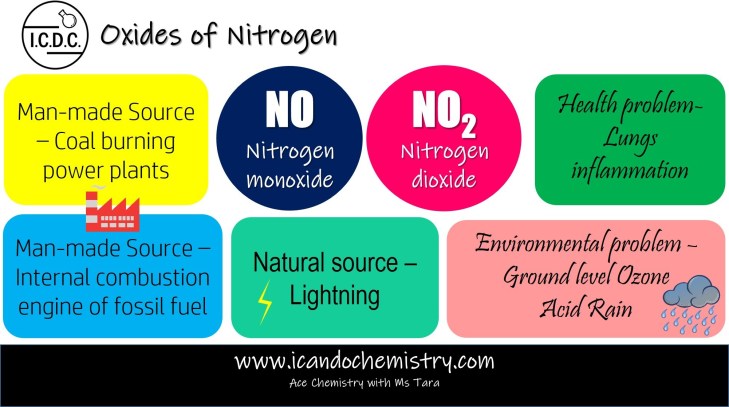
Nitrogen monoxide is also known as nitric oxide. It is colourless, odourless, neutral and water insoluble.
Nitrogen dioxide is a reddish brown and odourless gas. Unlike nitrogen monoxide, it is soluble in water to form nitric acid.
Sources of oxides of nitrogen
- Occurs naturally in lightning, source of nitrogen for plant growth
- Man-made source – Internal combustion engine of fossil fuel, coal burning power plants
Chemical Reaction
Oxides of nitrogen are formed at high temperature.
Nitrogen gas and oxygen gas react to form nitrogen monoxide.
Chemical equation: N2 (g) + O2 (g) → 2NO (g)
Nitrogen monoxide then reacts with more oxygen to form nitrogen dioxide.
Chemical equation: 2NO (g) + O2 (g) → 2NO2 (g)
Harmful Health Effects of Nitrogen Oxides
Irritation of lungs and leads to breathing difficulties. In more severe cases, lungs inflammation may result.
Harmful Environmental Effects of Nitrogen Oxides
Formation of ground level ozone
In the presence of Sun’s UV light, nitrogen dioxide reacts with oxygen gas to produce oxygen atoms.
NO2 (g) + O2 (g) ⇌ NO (g) + O (g) + O2 (g)
Oxygen atoms then react with oxygen molecules to form ozone.
O (g) + O2 (g) ⇌ O3 (g)
Ozone, at high altitude, protects us by absorbing harmful UV radiation from the Sun.
However, at ground level, it is a pollutant that irritates eyes, chests and throats. It also leads to asthma attacks.
Gives rise to acid rain
Nitrogen dioxide gives rise to acid rain. Nitrogen dioxide is an acidic gas. It reacts with oxygen and rain water to form nitric acid.
4NO2 (g) + 2H2O (l)+ O2 (g) → 4HNO3 (aq)
Unpolluted rainwater has a pH of around 5.6 due to carbon dioxide gas.
Carbon dioxide is an acidic gas, which dissolves in rainwater to form weak carbonic acid. This slight acidic is natural and harmless.
However, with the presence of man-made nitrogen dioxide and sulfur dioxide, the pH of rainwater will drop to around 4.
Harmful effects of acid rain
- Acid rain reacts with metals and carbonates. It corrodes limestone structures and buildings. It speeds up corrosion of metal structure like bridges and motor vehicles.
- Acid rain leaches nutrients from the soil needed by the plants for healthy growth. Plants wither and die. Acid rain react with aluminium hydroxide in the soil to produce Al3+ ions, which are toxic to plants.
- Acid rain reduces the pH value of lakes and streams, making it too acidic for aquatic life to survive.
Treatment of oxides of nitrogen
Ensure combustion in fuels is complete by fitting motor vehicles with catalytic converter which reduces oxides of nitrogen into harmless nitrogen gas.
